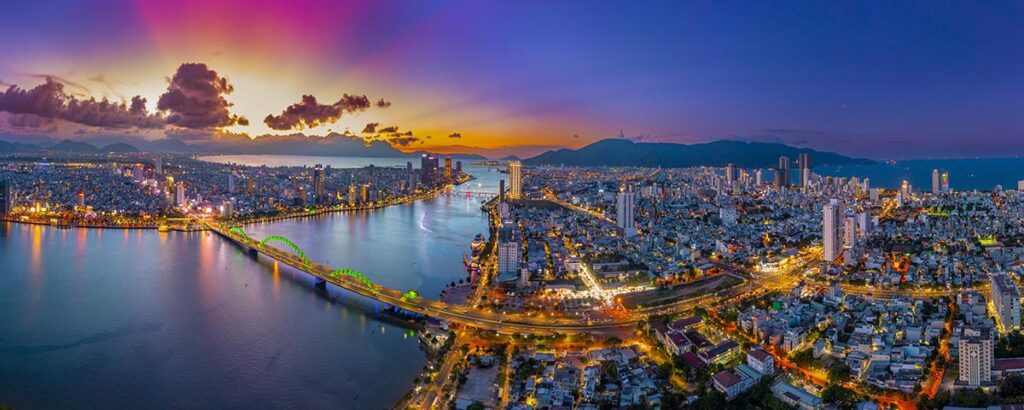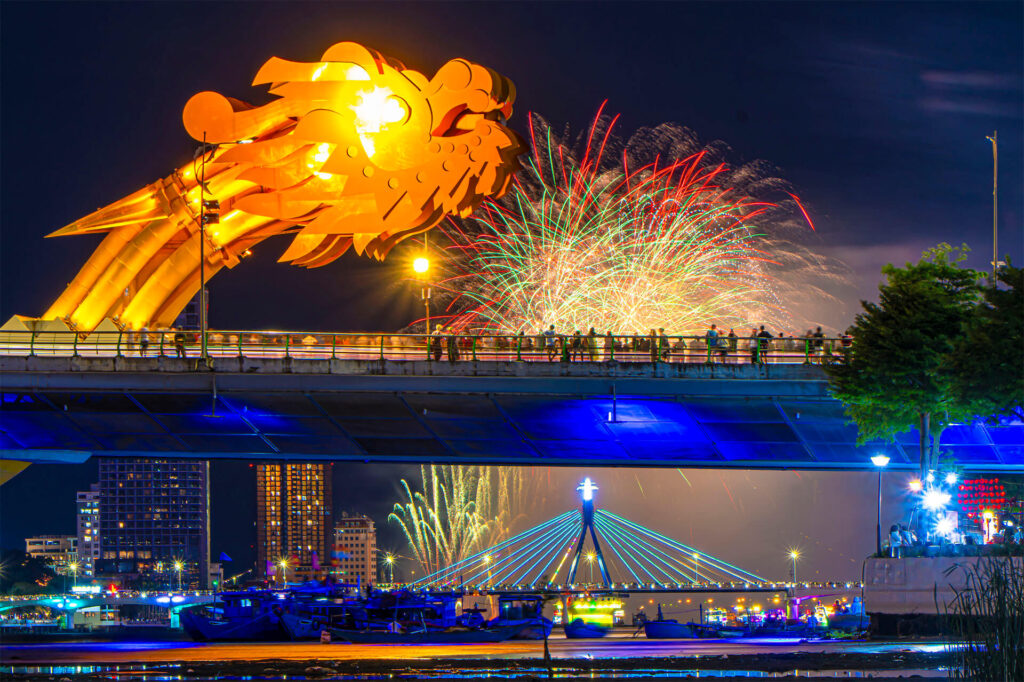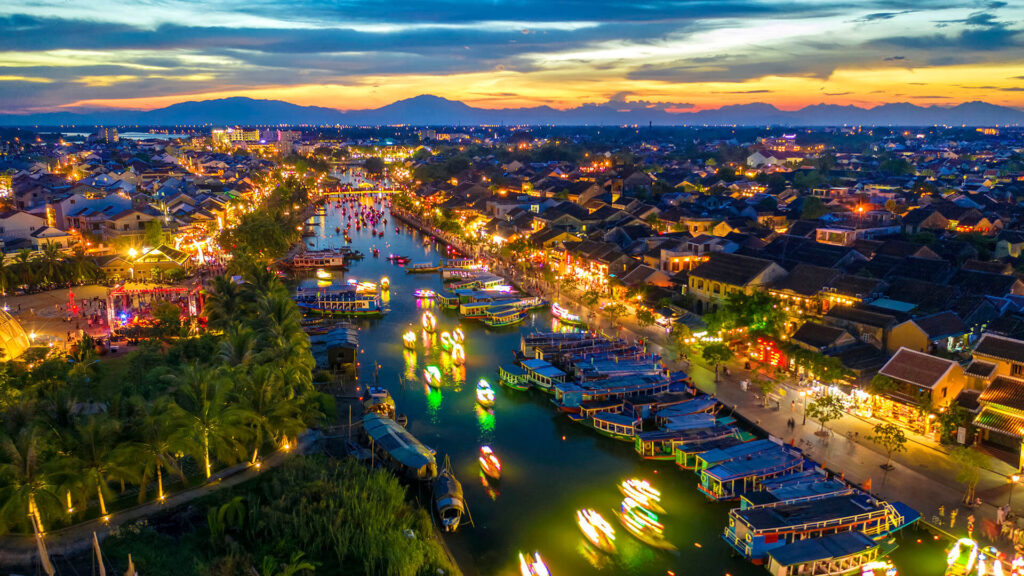Da Nang’s climate falls within the typical tropical monsoon zone, characterized by high and stable temperatures.

Brilliant Sunset over the City – Author: Nguyễn Thanh Hiệp
The newly established Da Nang City (after merging with Quang Nam Province) spans from the coastal plains to the western mountain ranges, lying entirely within the typical tropical monsoon climate zone. The average annual temperature is high and relatively stable, at about 25–26ºC. The climate here reflects a transitional character between northern and southern Vietnam, but it is largely dominated by the hot and humid tropical conditions of the South. Therefore, unlike the four distinct seasons of the North, the new Da Nang experiences only two main seasons each year: the rainy season and the dry season.
The relative humidity remains high throughout the year, averaging around 83–84%, creating the distinctive damp atmosphere of the Central Coast. Due to its diverse topography, the climate varies across regions: coastal and lowland areas (Da Nang, Hoi An, Tam Ky, etc.) experience hot and humid weather, with relatively small fluctuations in monthly temperatures. In the lowlands, summer temperatures generally range from 28–30ºC, with daytime peaks exceeding 35ºC and occasionally approaching 40ºC. Winters here are not too cold, with average temperatures around 20–24ºC, though they can drop close to 12ºC during strong monsoon spells. In contrast, the western mountainous areas enjoy cooler weather year-round thanks to higher elevations. Average temperatures in these regions are about 22–24ºC, with winter nights dropping below 10ºC in the highest locations.
The summit area of Ba Na Mountain (at an elevation of about 1,500 meters) even enjoys a temperate climate similar to Da Lat, with temperatures ranging from only 17–20ºC in the height of summer. The difference between daytime and nighttime temperatures in the mountains is also greater than in the lowlands (a variation of 8–10ºC), giving visitors a refreshing chill in the evening.

Here, Sun World Ba Na Hills —one of Vietnam’s most renowned tourist destinations—has been developed and has become a must-visit attraction for travelers.
In general, summers are hot while winters are not too cold. On the other hand, this area lies within the Western Pacific tropical depression zone and occasionally endures storms from the East Sea toward the end of the year. However, winter cold spells are neither prolonged nor as harsh as those in the northern provinces. With its stable and warm weather, Da Nang is a destination that can be visited almost year-round.
SOME SUGGESTIONS FOR TRAVELING TO DA NANG THROUGHOUT THE YEAR:
- Dry Season (January to August): The weather is generally cool to hot and dry. In the early months of the year (from late December to around March), the climate is mild and pleasant, with occasional light drizzle at the end of winter and early spring. From April onward, temperatures rise; during the peak of summer (June–July), the days are intensely hot, with daytime temperatures often ranging from 33–36ºC. Despite the heat, there is little heavy rain or storm activity during this period. The skies are usually clear and sunny, making it ideal for island getaways and outdoor sightseeing. This is considered the peak tourist season in Da Nang and its surrounding areas due to the prolonged stretch of beautiful weather.

Dry Season: With long stretches of sunshine and very little rainfall, this is the ideal time to explore all destinations, from My Khe Beach to Cu Lao Cham. Visitors can freely enjoy swimming, snorkeling, mountain trekking, picnicking, or taking part in outdoor festivals with hardly any concern about weather disruptions.

Many major cultural events and festivals are also held during the summer, most notably the Da Nang International Fireworks Festival, along with lively sports competitions and beach festivals that attract visitors from near and far. Travelers are advised to book services early to secure good rates and avoid shortages of accommodations during this peak period.
- Rainy Season (September to December): The autumn–winter period marks the rainy season in Central Vietnam. From mid-September, showers begin to appear more frequently; fortunately, early-season rains are usually short, lasting only 1–2 hours before clearing, so they do not greatly affect travel plans. From October onward, rainfall increases significantly. October, November, and December account for the majority of the annual rainfall, with high humidity levels. During this season, temperatures drop to cooler or mildly chilly levels: around 24–28ºC during the day and 18–22ºC at night. The rainy season typically ends by late December, when showers become less frequent and the weather transitions to the dry, cooler climate of the new year.

In fact, traveling in Da Nang during the rainy season offers its own unique charm. Visitors can stroll through the ancient streets of Hoi An in a tranquil, nostalgic atmosphere under the rain, enjoy steaming local cuisine, or relax in beautiful cafés and spas without the crowds. Service prices are also more affordable during this period, as many airlines and hotels launch attractive promotions and discounts—making it a great opportunity to save on travel expenses.
NOTES FOR VISITORS
When planning a trip to Da Nang, visitors should take note of several important points related to the region’s weather and climate:
- Choose the right time: If you prefer swimming, outdoor activities, and major festivals, it is best to visit during the dry season (around March–August). On the other hand, if you prefer fewer crowds and more budget-friendly options, consider traveling in the rainy season (September–December).
- Pack clothing and essentials: Da Nang generally has warm weather year-round, so light and comfortable summer clothing is suitable. However, late in the year and in the mountains, evenings can be chilly, so bring a light jacket. If you plan to visit higher-altitude areas such as Ba Na or Tay Giang, a thicker coat is recommended, as temperatures can drop below 15ºC. During the dry season with intense sunshine, be sure to bring hats, sunglasses, and sunscreen for protection. In the rainy season, an umbrella or a light raincoat is essential when going outdoors.
- Check the weather forecast: Before and during the trip, visitors should regularly keep up to date with local weather forecasts.
DANANG TOURISM PROMOTION CENTER